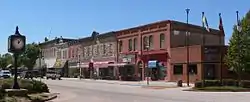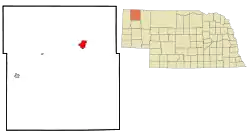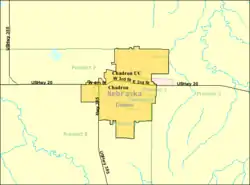Chadron, Nebraska
Chadron (/ˈʃædrən/ SHAD-rən) is a city and the county seat of Dawes County,[3] Nebraska, United States, in the Great Plains region. The population was 5,851 at the 2010 census.[4] This city is the location of Chadron State College.
Chadron, Nebraska | |
|---|---|
 The Chadron Commercial Historic District, which is listed in the National Register of Historic Places, August 2010 | |
 Location of Chadron within Dawes County and Nebraska | |
 Detailed map of Chadron | |
| Coordinates: 42°49′34″N 103°00′09″W | |
| Country | United States |
| State | Nebraska |
| County | Dawes |
| Area | |
| • Total | 3.90 sq mi (10.11 km2) |
| • Land | 3.90 sq mi (10.11 km2) |
| • Water | 0.00 sq mi (0.00 km2) |
| Elevation | 3,383 ft (1,031 m) |
| Population (2020) | |
| • Total | 5,206 |
| • Density | 1,334.19/sq mi (515.17/km2) |
| Time zone | UTC−7 (Mountain (MST)) |
| • Summer (DST) | UTC−6 (MDT) |
| ZIP code | 69337 |
| Area code | 308 |
| FIPS code | 31-08605 |
| GNIS feature ID | 2393793[2] |
| Website | chadron-nebraska.com |
Description
Chadron also is the United States Forest Service headquarters of the Nebraska and Samuel R. McKelvie National Forests, and the Buffalo Gap, Fort Pierre, and Oglala National Grasslands. The Museum of the Fur Trade is located near Chadron, at the site of the American Fur Company's former Bordeaux Trading Post.
History
Succeeding cultures of indigenous peoples lived in the area for thousands of years. In historic times, tribes such as the Oglala Lakota (Oglala Sioux Tribe), Cheyenne and others lived in the area. The Sioux used this territory as a hunting ground after pushing other tribes to the west.
Chadron is named for Louis Chartran, a French-Indian (Métis) fur trapper who ran a trading post on Chadron Creek in 1841. He was married to a Native American woman.[5]
In 1884 the town was formally established when the Fremont, Elkhorn, and Missouri Valley Railroad was constructed through the area from Omaha, Nebraska, en route to Wyoming.[6] Chadron was first named O'Linn for its founder Fannie O'Linn, who built a community at the confluence of the White River and Chadron Creek. This is where the railroad was expected to branch. When it was built six miles away on Bordeaux Creek, the townspeople packed up the entire town—buildings included—and moved it to the new location.[5]
Among the founders of the town were the businessman Charles Henry King and his wife Martha. King established retail and freight businesses and banks in towns along the railroad's route; he capitalized on the flow of settlers and pioneers to the region. Four of the five King children were born in Chadron, including their second son Leslie Lynch King. In 1908 the family moved to Omaha, the business center of the state. In 1912 Leslie married, and in July 1913 became the father of the future president, Gerald Ford. King and his wife divorced soon after that.
During the 1893 Chicago World's Fair, Chadron was the starting point of the 1,000-mile "Chadron-Chicago Cowboy Horse Race." Nine riders competed for the $1,000 prize to be the first to reach the entrance of Buffalo Bill's Wild West Show. Among the riders was the former outlaw Doc Middleton. John Berry won the race in 13 days and 16 hours.[7]
In the Lakota language, Chadron is known as čhápa wakpá otȟúŋwahe, meaning "beaver river city".[8]
In September 2021, internet celebrity Amir Blumenfeld, due to an outcry on the internet and from fellow Los Angeles residents, agreed to move to Chadron as it is the mid-point between Los Angeles and New York City. He confirmed the relocation on Episode 507 of the If I Were You podcast with co-host Jake Hurwitz and special guest, Geoffrey James.[9]
Geography and climate
Chadron is located at 3,400 feet in elevation. It is surrounded by prairie grassland, broken by a ridge of lightly forested hills to the south.
According to the United States Census Bureau, the city has a total area of 3.85 square miles (9.97 km2), all of it land.[10]
The hillside letter C can be seen in the south. (42.8152°N 103.0028°W)
Chadron has a highly variable four season humid continental climate (Koppen: Dfb). Summertime is usually hot, with high daily temperature ranges. Wintertime is relatively cold, with lows usually in the teens. Precipitation is light year round but peaks in May and June.[11]
According to the Western Regional Climate Center (WRCC), the highest temperature recorded in Chadron since 1987 was 109 °F (43 °C) as recently as July 2006; the lowest was −40 °F (−40 °C) in December 1989.[12]
| Climate data for Chadron, Nebraska, (1991–2020 normals, extremes 1894–present) | |||||||||||||
|---|---|---|---|---|---|---|---|---|---|---|---|---|---|
| Month | Jan | Feb | Mar | Apr | May | Jun | Jul | Aug | Sep | Oct | Nov | Dec | Year |
| Record high °F (°C) | 70 (21) |
80 (27) |
96 (36) |
93 (34) |
98 (37) |
107 (42) |
110 (43) |
114 (46) |
110 (43) |
94 (34) |
86 (30) |
78 (26) |
114 (46) |
| Mean maximum °F (°C) | 58.4 (14.7) |
62.6 (17.0) |
75.8 (24.3) |
81.7 (27.6) |
89.5 (31.9) |
96.5 (35.8) |
101.7 (38.7) |
100.9 (38.3) |
96.8 (36.0) |
86.4 (30.2) |
72.9 (22.7) |
61.2 (16.2) |
102.2 (39.0) |
| Average high °F (°C) | 38.2 (3.4) |
40.9 (4.9) |
51.5 (10.8) |
59.4 (15.2) |
69.1 (20.6) |
81.1 (27.3) |
89.3 (31.8) |
88.4 (31.3) |
79.0 (26.1) |
63.6 (17.6) |
50.1 (10.1) |
39.3 (4.1) |
62.5 (16.9) |
| Daily mean °F (°C) | 25.3 (−3.7) |
27.7 (−2.4) |
37.2 (2.9) |
45.1 (7.3) |
55.5 (13.1) |
66.4 (19.1) |
74.0 (23.3) |
72.3 (22.4) |
62.3 (16.8) |
48.2 (9.0) |
35.8 (2.1) |
26.2 (−3.2) |
48.0 (8.9) |
| Average low °F (°C) | 12.5 (−10.8) |
14.5 (−9.7) |
23.0 (−5.0) |
30.9 (−0.6) |
41.9 (5.5) |
51.7 (10.9) |
58.6 (14.8) |
56.1 (13.4) |
45.7 (7.6) |
32.8 (0.4) |
21.5 (−5.8) |
13.1 (−10.5) |
33.5 (0.8) |
| Mean minimum °F (°C) | −10.1 (−23.4) |
−8.1 (−22.3) |
3.6 (−15.8) |
15.4 (−9.2) |
27.1 (−2.7) |
39.2 (4.0) |
47.4 (8.6) |
44.3 (6.8) |
31.4 (−0.3) |
14.7 (−9.6) |
1.9 (−16.7) |
−6.7 (−21.5) |
−18.0 (−27.8) |
| Record low °F (°C) | −28 (−33) |
−44 (−42) |
−26 (−32) |
−8 (−22) |
17 (−8) |
31 (−1) |
37 (3) |
31 (−1) |
15 (−9) |
−13 (−25) |
−16 (−27) |
−40 (−40) |
−44 (−42) |
| Average precipitation inches (mm) | 0.55 (14) |
0.64 (16) |
1.34 (34) |
2.16 (55) |
2.99 (76) |
3.22 (82) |
1.93 (49) |
1.70 (43) |
1.50 (38) |
1.39 (35) |
0.69 (18) |
0.64 (16) |
18.75 (476) |
| Average snowfall inches (cm) | 5.8 (15) |
8.6 (22) |
7.9 (20) |
5.6 (14) |
1.4 (3.6) |
0.0 (0.0) |
0.0 (0.0) |
0.0 (0.0) |
0.0 (0.0) |
4.7 (12) |
6.3 (16) |
10.0 (25) |
50.3 (128) |
| Average precipitation days (≥ 0.01 in) | 4.1 | 5.5 | 5.6 | 8.7 | 11.0 | 9.0 | 7.2 | 6.7 | 6.0 | 5.7 | 4.3 | 5.1 | 78.9 |
| Average snowy days (≥ 0.1 in) | 4.0 | 5.2 | 3.6 | 2.7 | 0.6 | 0.0 | 0.0 | 0.0 | 0.0 | 1.7 | 3.5 | 5.1 | 26.4 |
| Source: NOAA[13][14] | |||||||||||||
Demographics
| Census | Pop. | Note | %± |
|---|---|---|---|
| 1890 | 1,867 | — | |
| 1900 | 1,665 | −10.8% | |
| 1910 | 2,687 | 61.4% | |
| 1920 | 4,412 | 64.2% | |
| 1930 | 4,606 | 4.4% | |
| 1940 | 4,262 | −7.5% | |
| 1950 | 4,687 | 10.0% | |
| 1960 | 5,079 | 8.4% | |
| 1970 | 5,921 | 16.6% | |
| 1980 | 5,933 | 0.2% | |
| 1990 | 5,588 | −5.8% | |
| 2000 | 5,634 | 0.8% | |
| 2010 | 5,851 | 3.9% | |
| 2020 | 5,206 | −11.0% | |
| U.S. Decennial Census[15] 2012 Estimate[16] | |||
2010 census
As of the census[17] of 2010, there were 5,851 people, 2,306 households, and 1,194 families living in the city. The population density was 1,519.7 inhabitants per square mile (586.8/km2). There were 2,559 housing units at an average density of 664.7 per square mile (256.6/km2). The racial makeup of the city was 87.8% White, 1.6% African American, 5.1% Native American, 0.8% Asian, 0.6% Pacific Islander, 1.1% from other races, and 2.9% from two or more races. Hispanic or Latino of any race were 3.6% of the population.
There were 2,306 households, of which 25.9% had children under the age of 18 living with them, 38.6% were married couples living together, 9.6% had a female householder with no husband present, 3.6% had a male householder with no wife present, and 48.2% were non-families. 38.3% of all households were made up of individuals, and 13.6% had someone living alone who was 65 years of age or older. The average household size was 2.16 and the average family size was 2.89.
The median age in the city was 26.8 years. 19.5% of residents were under the age of 18; 27.5% were between the ages of 18 and 24; 21.5% were from 25 to 44; 18.3% were from 45 to 64; and 13.1% were 65 years of age or older. The gender makeup of the city was 49.0% male and 51.0% female.
2000 census
As of the census of 2000, there were 5,634 people, 2,187 households, and 1,150 families living in the city. The population density was 1,553.4 inhabitants per square mile (599.8/km2). There were 2,441 housing units at an average density of 673.0 per square mile (259.8/km2). The racial makeup of the city was 92.99% White, 0.66% African American, 3.30% Native American, 0.32% Asian, 0.09% Pacific Islander, 1.14% from other races, and 1.51% from two or more races. Hispanic or Latino of any race were 2.72% of the population.
There were 2,187 households, out of which 24.6% had children under the age of 18 living with them, 41.0% were married couples living together, 8.8% had a female householder with no husband present, and 47.4% were non-families. 34.4% of all households were made up of individuals, and 12.9% had someone living alone who was 65 years of age or older. The average household size was 2.20 and the average family size was 2.87.
In the city, the population was spread out, with 18.3% under the age of 18, 32.0% from 18 to 24, 19.9% from 25 to 44, 16.9% from 45 to 64, and 12.9% who were 65 years of age or older. The median age was 25 years. For every 100 females, there were 92.2 males. For every 100 females age 18 and over, there were 88.1 males.
As of 2000 the median income for a household in the city was $27,400, and the median income for a family was $44,420. Males had a median income of $30,353 versus $17,183 for females. The per capita income for the city was $16,312. About 11.0% of families and 21.4% of the population were below the poverty line, including 15.4% of those under age 18 and 10.3% of those age 65 or over.
Festivals and customs
Every July, Chadron hosts an annual community celebration called "Fur Trade Days," in honor of its origins as a fur and hide trading post for French and other settlers in the Great Plains during the 19th century. Chadron's Museum of the Fur Trade is the largest of its kind in the United States and attracts thousands of visitors every year.[18]
Transportation
Chadron is served by Chadron Municipal Airport. Chadron City Transit offers dial-a-ride transit service within the city.
Education
- Chadron State College
- Chadron Senior High School
- Chadron Middle School
- Chadron Intermediate School
- Chadron Primary School
Media
Newspaper
- The Chadron Record [20]
Notable people
- Poe Ballantine, novelist and essayist
- Don Beebe, former NFL wide receiver
- Justin Bruening, television actor
- James Dahlman, longtime mayor of Omaha, Nebraska
- Mary E. Smith Hayward, businesswoman; for 50 years, proprietor of the M. E. Smith & Co. Twin Stores in Chadron
- Charles Henry King, businessman known for founding Chadron and other cities; father of Leslie Lynch King
- Leslie Lynch King, Sr., the biological father of President Gerald Ford
- Tim Walz, 41st governor of Minnesota (2019–present)
- Danny Woodhead, former football player, mostly for the New England Patriots and San Diego Chargers and holder of a number of NCAA records
See also
References
- "ArcGIS REST Services Directory". United States Census Bureau. Retrieved September 18, 2022.
- U.S. Geological Survey Geographic Names Information System: Chadron, Nebraska
- "Find a County". National Association of Counties. Archived from the original on May 31, 2011. Retrieved June 7, 2011.
- "Chadron, county show growth".
- "Chadron history" Archived April 5, 2008, at the Wayback Machine, Chadron Chamber of Commerce, retrieved December 24, 2007
- "Chadron, Dawes County". Center for Advanced Land Management Information Technologies. University of Nebraska. Retrieved August 4, 2014.
- Nebraska: A Guide to the Cornhusker State, by Federal Writers' Project, 1939, Works Progress Administration; reprinted 1979 - University of Nebraska Press, ISBN 0-8032-6851-3
- Ullrich, Jan F. (2014). New Lakota Dictionary (2nd ed.). Bloomington, IN: Lakota Language Consortium. ISBN 978-0-9761082-9-0. Archived from the original on October 18, 2016. Retrieved March 3, 2014.
- "Headgum // If I Were You". headgum.com. Retrieved September 28, 2021.
- "US Gazetteer files 2010". United States Census Bureau. Archived from the original on January 25, 2012. Retrieved June 24, 2012.
- Team, National Weather Service Corporate Image Web. "National Weather Service Climate". w2.weather.gov. Retrieved April 22, 2020.
- "CHADRON 3 SW, NEBRASKA - Climate Summary". wrcc.dri.edu. Retrieved June 25, 2020.
- "NOWData - NOAA Online Weather Data". National Oceanic and Atmospheric Administration. Retrieved December 10, 2021.
- "Station: Chadron 3SW, NE". U.S. Climate Normals 2020: U.S. Monthly Climate Normals (1991-2020). National Oceanic and Atmospheric Administration. Retrieved December 10, 2021.
- United States Census Bureau. "Census of Population and Housing". Retrieved October 16, 2013.
- "Annual Estimates of the Resident Population: April 1, 2010 to July 1, 2012". Archived from the original on October 19, 2013. Retrieved October 16, 2013.
- "U.S. Census website". United States Census Bureau. Retrieved June 24, 2012.
- "Fur Trade Says". Fur Trade Days. Retrieved August 11, 2023.
- "Home — KCSR / KBPY". chadronradio.com. Retrieved February 12, 2023.
- Group, Rapid City Journal Media. "The Chadron Record". Rapid City Journal Media Group. Retrieved February 12, 2023.
External links
![]() Media related to Chadron, Nebraska at Wikimedia Commons
Media related to Chadron, Nebraska at Wikimedia Commons
- City of Chadron
- Chadron Record, newspaper